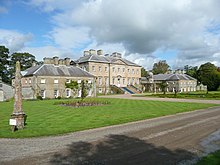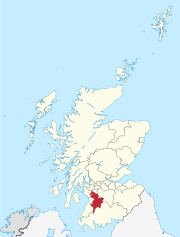world.wikisort.org - United_Kingdom
Cumnock (Cumnag in Gaelic) is a town in East Ayrshire, Scotland. The town sits at the confluence of the Glaisnock Water and the Lugar Water. There are three neighbouring housing projects which lie just outside the town boundaries, Craigens, Logan and Netherthird, with the former ironworks settlement of Lugar also just outside the town, contributing to a population of around 13,000 in the immediate locale. A new housing development, Knockroon, was granted planning permission on 9 December 2009 by East Ayrshire Council.[2]
Cumnock
| |
|---|---|
| Town | |
 Cumnock town centre showing Glaisnock Street | |
 Cumnock Location within East Ayrshire | |
| Population | 8,700 (mid-2020 est.)[1] |
| Language | English Scots |
| OS grid reference | NS569200 |
| • Edinburgh | 54 mi (87 km) |
| • London | 321 mi (517 km) |
| Council area |
|
| Lieutenancy area |
|
| Country | Scotland |
| Sovereign state | United Kingdom |
| Post town | CUMNOCK |
| Postcode district | KA18 |
| Dialling code | 01290 |
| Police | Scotland |
| Fire | Scottish |
| Ambulance | Scottish |
| UK Parliament |
|
| Scottish Parliament |
|
The town is home to the Robert Burns Academy, a new educational campus housing the main Robert Burns Academy secondary school following the merger of Cumnock Academy and Auckinleck Academy, Lochnorris Primary School and Cherry Trees Early Childhood Centre. The campus is the largest educational establishment in Scotland.[3]
History

Early Cumnock
Etymology
The origin of the name "Cumnock" has been debated over the years and several interpretations have been offered.
- Com-cnoc, (hollow of the hills)
- Com-oich, (meeting of the waters)
- Cam-cnoc, (crooked hill)
- Cumanag, (little shrine)[4]
Early history
This part of Ayrshire has seen human settlement for over 5,000 years. There are many Bronze Age burial sites around the nearby area.[4]
Medieval history
It is believed that a place of worship has existed in Cumnock's Square for over 1,100 years, though the records begin in about 1275. The patron saint of Cumnock is Saint Conval. James IV created the Burgh of Cumnock.[4] Three castles existed in the parish of Old Cumnock, namely Borland, Terringzean and Lefnories or Lochnorris. Lefnories was the largest and was replaced as a dwelling by Dumfries House, with only the below ground foundations remaining, excavated by the Marquess of Bute in the late 19th century.[5]
William Wallace allegedly spent three months in the seat of Patrick Dunbar ((New) Cumnock or Cumno in 1296), according to the poem The Wallace, by Blind Harry. Robert the Bruce, Robert I, was in Cumnock in 1307 being pursued by two of Edward I's men: Aymer de Valence, 2nd Earl of Pembroke, and John MacDougall of Lorn. The latter used Bruce's own bloodhound to track him. Bruce evaded capture and the bloodhound lost the scent when Bruce waded into a stream.[6]
Industrial Cumnock
The town has a strong socialist heritage due to its history as a mining centre. The father of the Labour Party, James Keir Hardie, lived in the town for a large part of his life,[7] and his statue sits outside Cumnock Town Hall. The left-wing politician Emrys Hughes was local MP for a time in the mid-20th century, and also lived in the town.[8]
Churches

The town has six churches, five Protestant churches, the Congregational Church, Old Cumnock Old Parish Church, St Andrew's United Free Church, Cumnock Trinity Church, Cumnock Baptist Church, and the Roman Catholic St John the Evangelist Church (1878–1880), by architect William Burges for the third Marquess of Bute.[9][10]
Sports
The local football team is Cumnock Juniors, who compete in the West of Scotland League Premier Division and play their home matches at Townhead Park. The team is famous for their bitter rivalry with local neighbours, Auchinleck Talbot. The town also boasts an athletics park and rugby club Cumnock RFC, as well as a modern sports centre containing fitness gym and swimming pool.[11]
Notable residents
- Mark Bennett, Scottish international rugby player
- James MacMillan, composer
- George Burley, former footballer mostly playing for Ipswich Town, and manager for Ipswich Town, Derby County etc.
- Craig Burley, former footballer mostly playing for Celtic, Chelsea and Derby County, now a pundit on ESPN FC
See also
- Cumnock and Holmhead
- Terringzean Castle
- Black Loch, New Cumnock
- Lands of Borland, Barony of Cumnock
References
- "Mid-2020 Population Estimates for Settlements and Localities in Scotland". National Records of Scotland. 31 March 2022. Retrieved 31 March 2022.
- East Ayrshire Council Archived 2011-04-06 at the Wayback Machine
- Hilley, Sarah (8 October 2020). "Scotland's biggest school will be finished tomorrow in East Ayrshire". Daily Record. Retrieved 31 October 2021.
- Cumnock History Group
- Paterson, James (1863). History of the counties of Ayr and Wigton. Vol.1 Kyle. James Stillie. p. 326.
- Thomson, Thomas (1895). A History of the Scottish People from the Earliest Times. pp. 220–21.
- Stewart, William (1925). J. Keir Hardie: A Biography (rev. ed.). London: Independent Labour Party Publication Department. p. 25.
- "Hughes, Emrys Daniel (1894 - 1969), politician, journalist and author". Dictionary of Welsh Biography. Retrieved 30 July 2022.
- "St John the Evangelist, Cumnock". Scotland's Churches Trust. 24 September 2017. Retrieved 31 October 2021.
- "Cumnock, Car Road, St John's Roman Catholic Church". Canmore: National Record of the Historic Environment. Historic Environment Scotland. Retrieved 31 October 2021.
- "Visions Leisure, Swimming Pool, Fitness Facilities". Archived from the original on 17 December 2004.
External links
- Cumnock History Group Cumnock History Group site, extensive information on the history of Cumnock
- Cumnock Action Plan
- cumnockchronicle The local community site for Cumnock, more information on Cumnock
- tripod.com more information on The Wallace
- Video footage of the Moot Hill, Gallows Hill, etc.
На других языках
[de] Cumnock (Schottland)
Cumnock (gälisch: Cumnag[1]) ist eine Stadt im Zentrum der schottischen Council Area East Ayrshire. Sie liegt am Zusammenfluss von Glaisnock Water und Lugar Water rund 20 km südöstlich von Kilmarnock und 60 km nordwestlich von Dumfries.[2]- [en] Cumnock
Другой контент может иметь иную лицензию. Перед использованием материалов сайта WikiSort.org внимательно изучите правила лицензирования конкретных элементов наполнения сайта.
WikiSort.org - проект по пересортировке и дополнению контента Википедии
